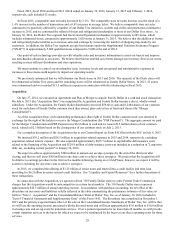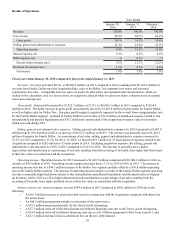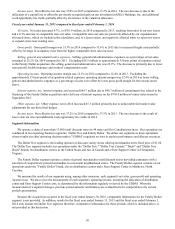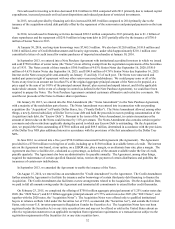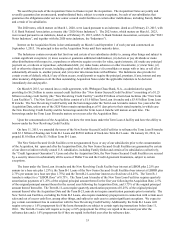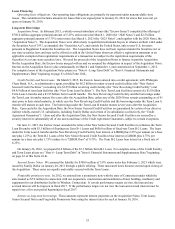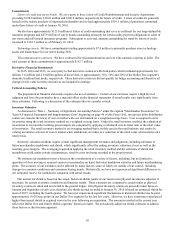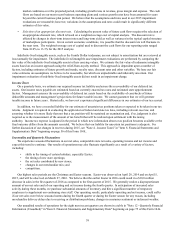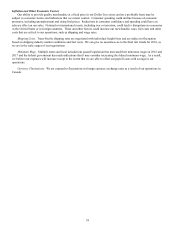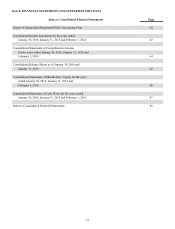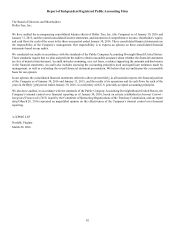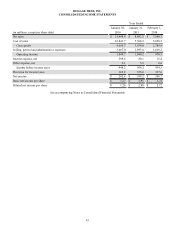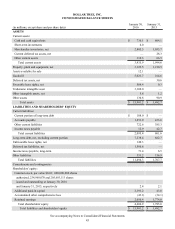Dollar Tree 2015 Annual Report Download - page 53
Download and view the complete annual report
Please find page 53 of the 2015 Dollar Tree annual report below. You can navigate through the pages in the report by either clicking on the pages listed below, or by using the keyword search tool below to find specific information within the annual report.37
Our management believes that our application of the retail inventory method results in an inventory valuation that
reasonably approximates cost and results in carrying inventory at the lower of cost or market each year on a consistent basis.
In our Family Dollar segment, we receive vendor support in the form of cash payments or allowances through a variety of
reimbursements such as purchase discounts, cooperative advertising, markdowns, scandowns, and volume rebates. We have
agreements with vendors setting forth the specific conditions for each allowance or payment. In accordance with ASC 605-50,
"Revenue Recognition - Customer Payments and Incentives," depending on the arrangement, we either recognize the allowance
as a reduction of current costs or recognize the benefit over the period the related merchandise is sold. If the payment is a
reimbursement for costs incurred, it is offset against those related costs; otherwise, it is treated as a reduction to cost of goods
sold.
Accrued Expenses
On a monthly basis, we estimate certain expenses in an effort to record those expenses in the period incurred. Certain
expenses, such as legal reserves, require a high degree of judgment and our most material estimates include domestic freight
expenses, self-insurance costs, store-level operating expenses, such as property taxes and utilities, and certain other expenses.
We are involved in numerous legal proceedings and claims. Our accruals, if any, related to these proceedings and claims
are based on a determination of whether or not the loss is both probable and estimable. We review outstanding matters with
external counsel to assess the probability of an unfavorable outcome and estimates of loss. We re-evaluate outstanding
proceedings and claims each quarter or as new and significant information becomes available, and we adjust or establish
accruals, if necessary. Our legal proceedings are described in "Note 5 - Commitments and Contingencies" under the caption
"Contingencies" in "Item 8. Financial Statements and Supplementary Data" beginning on page 59 of this Form 10-K.
Our freight and store-level operating expenses are estimated based on current activity and historical trends and results. Our
workers' compensation, general liability and health insurance accruals are recorded based on third-party actuarial valuations
which we obtain at least annually. For our workers' compensation and general liability accruals, these actuarial valuations are
estimates based on our historical loss development factors. For our health insurance accrual, the actuary provides an estimate
based on historical claims and claim payment timing. Certain other expenses are estimated and recorded in the periods that
management becomes aware of them. The related accruals are adjusted as management’s estimates change.
Differences in management's estimates and assumptions could result in expenses which are materially different from the
calculated accruals. Our experience has been that some of our estimates are too high and others are too low. Historically, the
net total of these differences has not had a material effect on our financial condition or results of operations.
Business Combinations-Purchase Price Allocation
For the Family Dollar acquisition, we allocated the purchase price to the various tangible and intangible assets acquired
and liabilities assumed, based on their estimated fair values, which are preliminary as of January 30, 2016. Determining the
fair value of certain assets and liabilities is subjective in nature and often involves the use of significant estimates and
assumptions, which are inherently uncertain. We engaged third party experts to assist in the determination of fair value for
complex assets and liabilities. Many of the estimates and assumptions used to determine fair values, such as those used for
intangible assets are made based on forecasted information and discount rates. In addition, the judgments made in determining
the estimated fair value assigned to each class of assets acquired and liabilities assumed, as well as asset lives, can materially
impact our results of operations.
Goodwill and Other Indefinite-Lived Intangible Assets
Indefinite-lived intangible assets are initially recorded at their fair values. These assets, including goodwill, are not
amortized but are evaluated annually for impairment. An additional evaluation is performed if events or circumstances indicate
that impairment could have occurred. Such events or circumstances could include, but are not limited to, significant negative
industry or economic trends, unanticipated changes in the competitive environment and a significant sustained decline in the
market price of our stock.
For purposes of our goodwill impairment evaluation, the reporting units are Family Dollar, Dollar Tree and Dollar Tree
Canada. Goodwill has been assigned to the reporting units based on prior business combinations related to the brands. We
estimate the fair value of our reporting units using projected future cash flows that are discounted using a weighted-average
cost of capital analysis that reflects current market conditions. Management judgment is a significant factor in the goodwill
impairment evaluation process. The computations require management to make estimates and assumptions. Actual values may
differ significantly from these judgments, particularly if there are significant adverse changes in the operating environments for
our reporting units. Critical assumptions that are used as part of these evaluations include:
• The potential future cash flows of the reporting unit. The projections use management's estimates of economic and



